North Korea Launched Its Biggest Missile Yet: Is the U.S. Now Within Range?
Experts give their best guess after latest test.

North Korea performed the first test launch Wednesday of its latest missile, the Hwasong-15. The Kim Jong-un government, the United States, and outside experts have all suggested this new missile could have the range to reach not just the American mainland but clear across to targets on the Eastern seaboard like New York and Washington, D.C.
Figuring out whether that’s actually true is no easy task. The secrecy of the test means outside observers work with fragmentary information at best. And neither the North Korean nor the United States governments should be considered totally reliable sources, as their claims are filtered through their foreign policy objectives.
What reports do indicate — both from North Korea’s official announcement and from others tracking the test — is the Hwasong-15 flew for just under an hour. As is common for such tests, it took what’s known as a lofted trajectory, where it flew much higher vertically than it traveled horizontally. It reached nearly 3,000 vertical miles in altitude but only flew about 600 miles from the launch site before crashing into the Sea of Japan.
“If these numbers are correct, then if flown on a standard trajectory rather than this lofted trajectory, this missile would have a range of more than 13,000 kilometers (km) (8,100 miles),” David Wright, a physicist and the director of the Global Security Program for the Union of Concerned Scientists, writes in his blog. “This is significantly longer than North Korea’s previous long range tests, which flew on lofted trajectories for 37 minutes (July 4) and 47 minutes (July 28). Such a missile would have more than enough range to reach Washington, D.C., and in fact any part of the continental United States.”
That’s a potentially huge — and worrisome — advance for North Korea’s nuclear weapons program, but there’s a really big caveat to keep in mind here. A missile is only as dangerous as its payload, and there’s still no indication this missile is capable of carrying the weight of an armed nuclear warhead. Indeed, Wright argues there’s good reason to think the Hwasong-15 couldn’t have achieved the reported figures without being stripped of any potential offensive capability.
“We do not know how heavy a payload this missile carried, but given the increase in range it seems likely that it carried a very light mock warhead,” he writes. “If true, that means it would be incapable of carrying a nuclear warhead to this long distance, since such a warhead would be much heavier.”
A broadcast in Seoul, South Korea, reporting the most recent missile launch.
There also remains a big difference between a missile’s range — which is just how far it can reach — and its ability to hit an actual target. Saying New York is in range of the Hwasong-15 isn’t the same thing as saying North Korea could actually fire at the city and expect any accuracy.
“North Korea’s aim is famously poor, and accurately directing a long-range missile that throws warheads halfway around the world is extraordinarily challenging,” the New York Times explained in a September report. “One estimate for North Korea, based on the accuracy of other first-generation ICBMs, ranges between three and five kilometers, or about two to three miles. The true accuracy is impossible to determine because the North’s warheads usually fall into the sea, and outside experts know little about its intended targets.”
The jump in range may then matter less than another potential advance that came with this latest test, as a blog post from the Bulletin of the Atomic Scientists notes.
“Some North Korea-watchers theorize that North Korea fueled the missile horizontally before placing it on the launchpad—thus saving the country’s military leadership the several days involved in rolling a missile vertically onto a launchpad, filling it with liquid fuel, and then launching it,” Dan Drollette Jr. writes on the site. “Crucially, this shortens the window of opportunity during which the rockets could be spotted by the United States or its allies before launch.
This week’s launch still appears to represent a big step forward technologically for North Korea, so it definitely shouldn’t be dismissed. But the most tangible threat likely isn’t the direct danger of the Kim Jong-un government launching a missile at Washington, D.C., but rather how this perceived capability further escalates tensions between the country, its neighbors like South Korea and Japan, and the United States — particularly with the generally more bellicose Trump administration calling the shots.